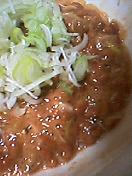|
Capability of Soybeans
− Wisdom of Japanese-style Foods Draws World's Attention
|
The functions of soybeans are getting attention of consumers. Soybeans are really capable unlike many items that have emerged in healthy food boom only temporarily and quickly disappeared. While soybeans have been playing an important role comparable even to that of rice in the traditional Japanese diets, their great capability is getting renewed attention as a result of a light of science shed on them. We will do well to take advantage of their capability in our future diets.
Once, a TV quiz program was doing a question to ask if
"Edamame [boiled beans in pods] was green soybean." That this was taken up as a question suggests that not a few people know about it.
|
 |
It has been pointed out for some time now that many consumers do not know about agricultural products which are used as ingredients of food. We encounter with stories here and there that say "A hen drawn up had four
legs," "Some people thought an eggplant grows under soil
surface," and "Others were surprised to know that a cow can not milk without delivering a calf."
Short-lived boom of a specific food could be occurring among the people when they are exposed to piecemeal information, who do not have basic knowledge of foods. When people are told that "a certain food works well against cancer," the item disappears right away from shop shelves.
More recently, however, some items have outlived short period of a boom and take deeper root when detail information about them spread. Top on
the list is soybean. As functional ingredients of soybeans such as "peptides" and
"isoflavone" have come to be known by many, a number of manufacturers have started making functional drinks of soybeans and selling them under emphatic commercial ads. Certainly, functional drinks and supplements - nutrition supplementing foods - have advantage of ready intake (without bothering to cook), but nutritive elements are rather to be taken from table meals as a matter of basics.
Japanese-style diets, centered on rice, incorporate a good balance of vegetables, fruits, livestock products, fish and seaweeds etc. Especially, combinations of rice, soybeans and soybean products as represented by "rice and
Misoshiru [bean-paste-based soup] " are indispensably important components.
From the standpoint of nutrition, soybeans supplement lysine, i.e. essential amino acid, which is deficient in rice while rice supplement
methionine, i.e. another form of essential amino acid, which is somewhat deficient in soybeans. Rice and beans are the best partners.
As the global population expands rapidly in the future, the issue of food supply can not be ignored. How to secure proteins will become a major issue, not to mention
cereal supplies. Expectation on plant proteins will, without mistake, grow larger along with developments of livestock production and marine resources such as fish and shellfish.
Renewed appreciation being made of beans including soybeans which are rich in proteins and having such excellent functions is becoming a major trend of the world. The wisdom of traditional Japanese diets that incorporates soybeans not just as beans but also in processed forms like
Miso [soybean paste], Tofu [bean curds] and Natto
[fermented soybeans] is getting attention of the world.
(from an editorial in the August 22, 2005 issue of the Nihon Nogyo
Shinbun)
[Top of Page]
|